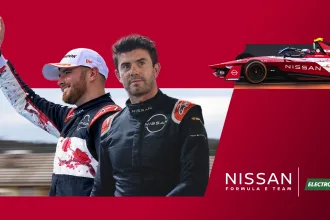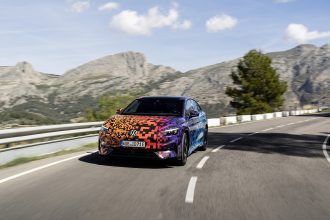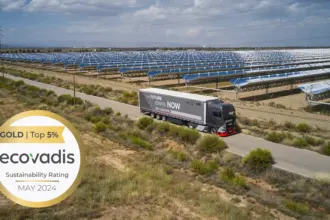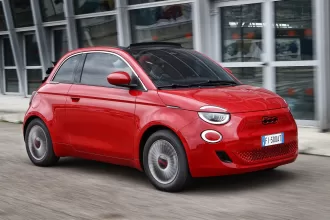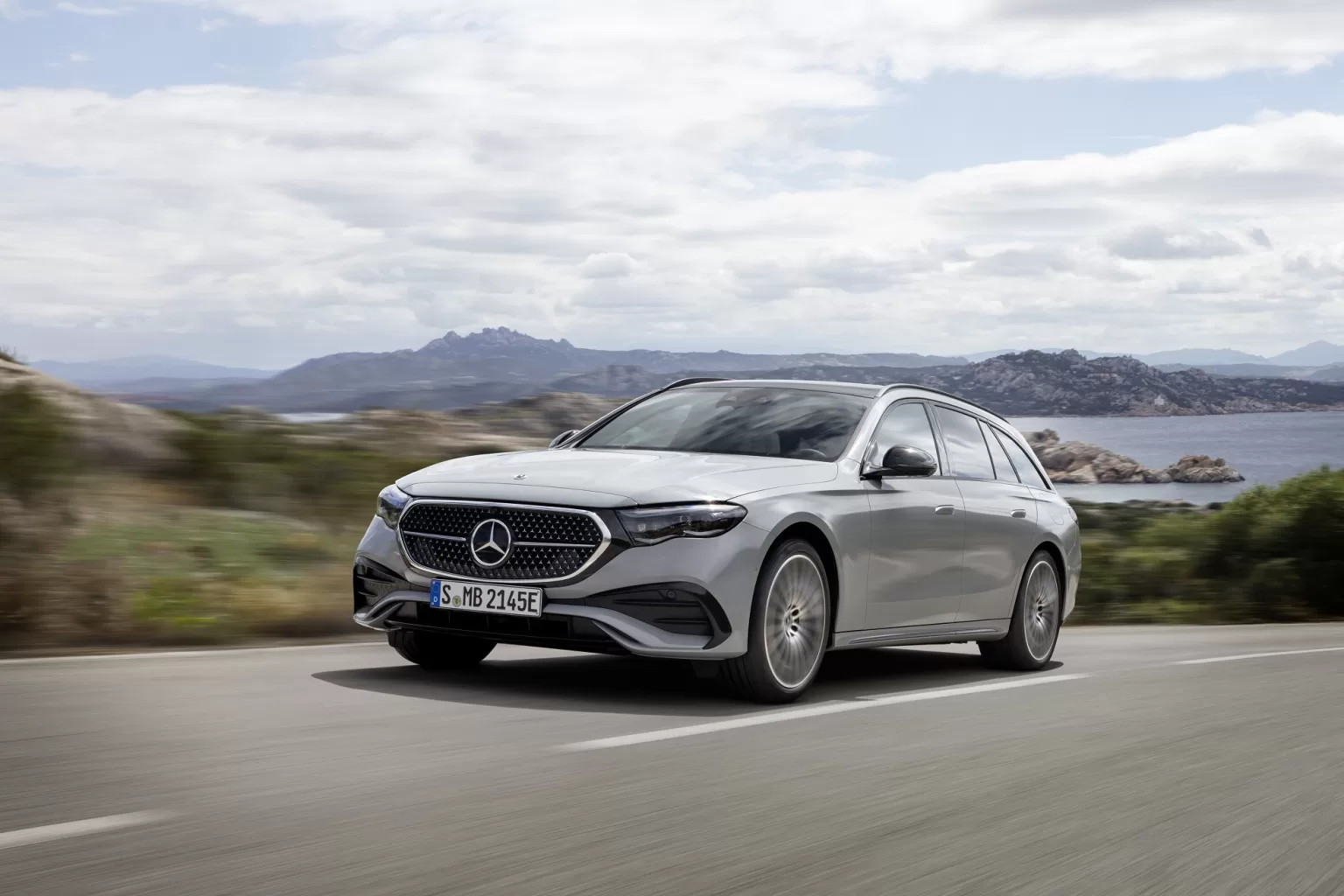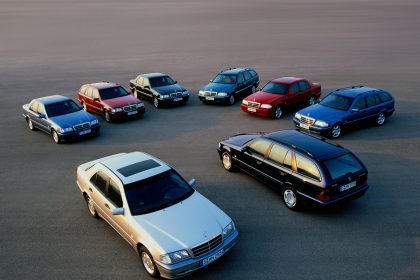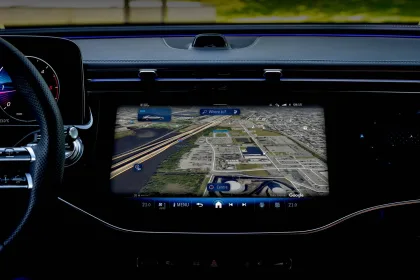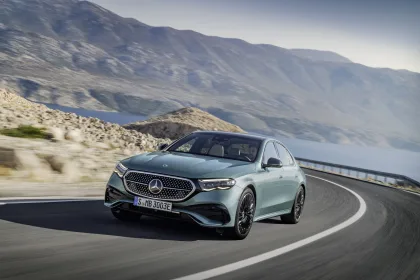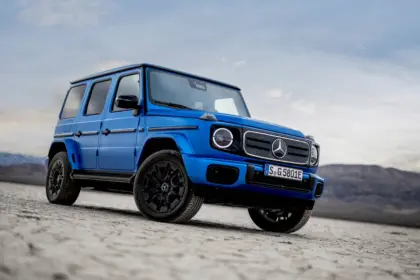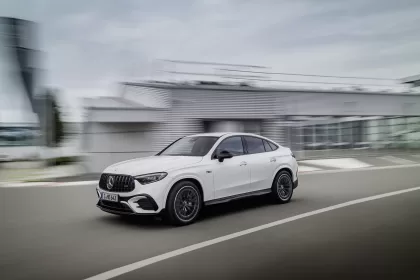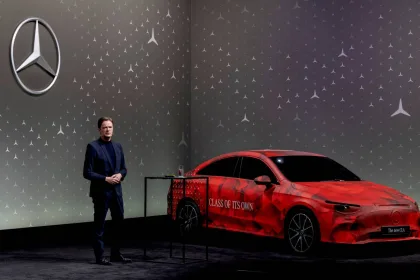- Distinctive side profile with dynamic roof line
- The familiar high utility value and generous space
As functional as its predecessor, as intelligent and customisable as never before: The new E‑Class Estate, model series 214, impresses in many areas. The design has also changed: The roofline is more dynamically designed compared to its predecessor, and at the same time the new E-Class Estate scores again with functionality and load compartment volume. Combined with the raked rear window, the overall appearance is progressive.
Like the Saloon before it, the Estate not only continues the long model history of the classic E-Class, but also bridges the gap to the avant-garde trendsetters from Mercedes-EQ with its new design. Balanced proportions are part of the appearance of a classic estate car. They are defined by the short front overhang, the long bonnet with powerdomes, the longer wheelbase and the balanced rear overhang.
With its distinctive side profile, the Estate clearly sets itself apart from the competition. The two character lines familiar from the Saloon create a powerfully stretched car body and give the Estate a sporty and stylish appearance. Sophisticated, three-dimensional and optimised down to the last detail, the surface finish exudes elegance.
A black panel-like surface connects the radiator grille with the headlamps. This insert in high-gloss black is visually reminiscent of the Mercedes-EQ models. The three-dimensionally designed radiator grille is either progressive or classic, depending on the equipment line. A chrome-framed radiator grille backlit by optical fibres is optionally available for all lines (Avantgarde, Exclusive and AMG Line). The new E-Class Estate features LED High Performance headlamps as standard. As an optional extra, DIGITAL LIGHT is available without and with a projection function. All headlamp variants offer a distinctive day and night design. As a typical feature of the brand, the daytime running lights take the shape of an eyebrow.
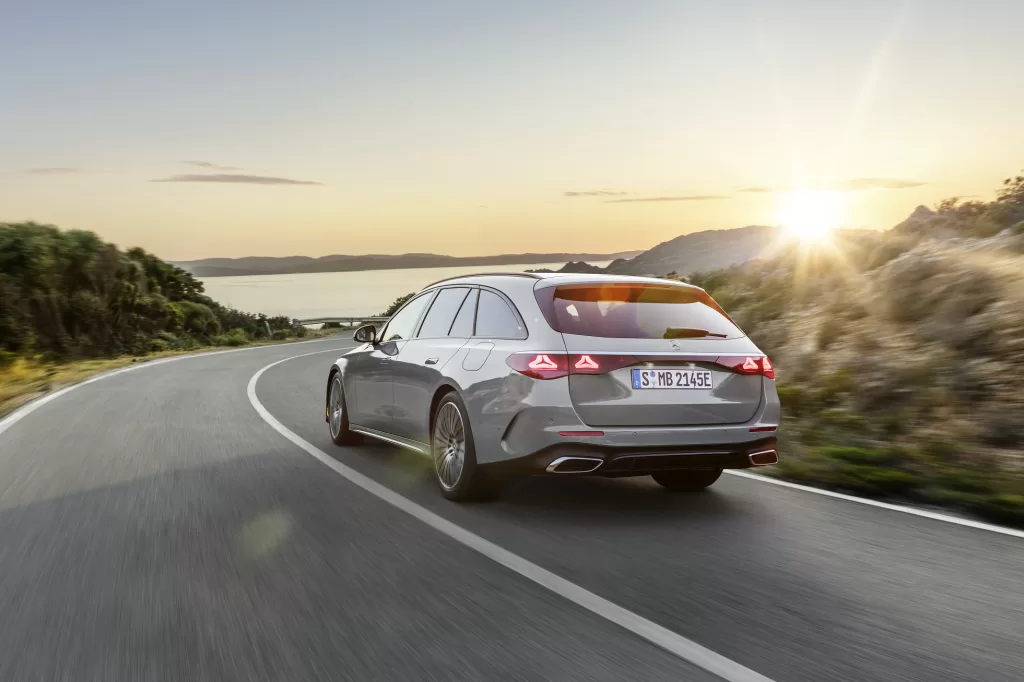
Precisely designed chrome elements as well as the progressively styled, two-part rear lamps characterise the rear-end design. Thanks to its large opening, the load compartment can be used in a variety of ways. The design team has reinterpreted the rear lamps in terms of their contours and inner workings. With great depth of detail and partly animated functions, the interior design contributes to the vehicle’s high value appeal. The unique star motif makes the day and night design of the rear lamps unmistakable. The two light sections in the side wall and boot lid are visually connected. This further emphasises the width of the rear. The reflectors have been relocated to the bumper. Because this allowed the load compartment opening to be particularly large, this increases the utility value on the one hand and makes the rear view look even wider on the other.
Even more spacious in the rear and the familiar high utility value
Compared to its predecessor, the E-Class Estate has increased in width by 28 millimetres. This gives the rear passengers even more space: The elbow room in the rear is 1519 millimetres – 25 millimetres more than before. The wheelbase has increased by 22 millimetres to 2961 millimetres. As a result, rear-seat passengers enjoy more knee room (84 millimetres; plus 9 millimetres) and leg room (934 millimetres; plus 15 millimetres). The load compartment can be expanded from 615 litres to up to 1830 litres. In the plug-in hybrid model, the luggage capacity is 460–1675 litres, and the load compartment is level there, too.
The seat backrests can be split and folded down in a 40:20:40 ratio. Operation is by two push buttons on the left and right side of the rear seat backrest. The Estate model features the EASY-PACK tailgate as standard. The tailgate opens and closes conveniently at the touch of a button: using the button on the ignition key, the switch in the driver’s door or the release handle on the tailgate. The retractable luggage cover and dividing net (both standard) have a two-piece design. Each has its own roller cassette.
MBUX Superscreen as a highlight of the interior design
The dashboard makes for the digital experience in the interior. If the E-Class Estate is equipped with the optional front passenger screen, the large glass surface of the MBUX Superscreen extends to the central display. Visually detached from this is the driver’s display in the driver’s field of vision. The models without a passenger display feature a large trim element that extends to the centre. Visually detached, the central display appears to float above the concave surface of this trim element.
The front section of the instrument panel is illuminated by the light strip of the Active Ambient Lighting. This runs in a wide arc from the windscreen, past the A-pillars and into the doors. This creates a generous feeling of space. An apparently free-floating control array in the upper section of the door panels matches the look of the glass surfaces of the screens.
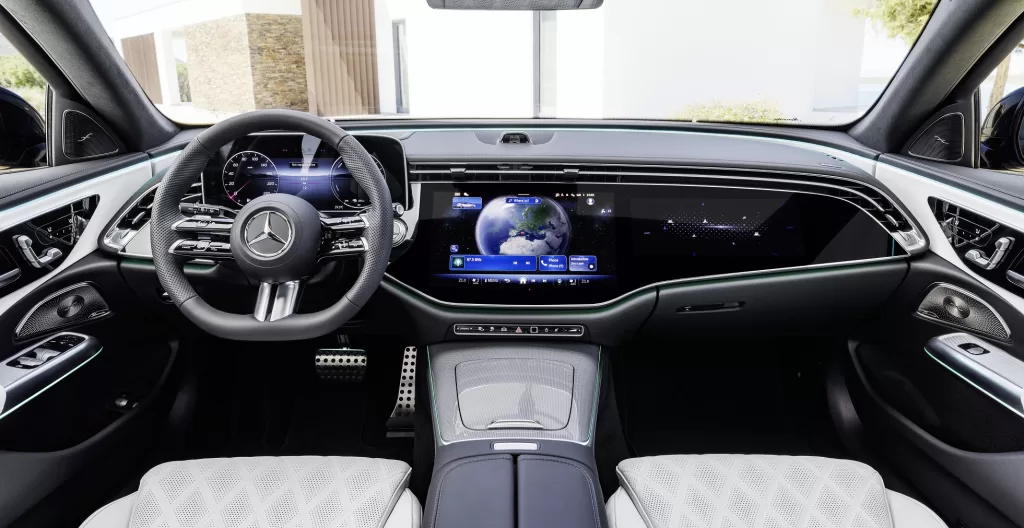
The centre console is designed as a homogeneous unit and merges in a straight line into the lower section of the dashboard. At the front, a stowage compartment with lid and cup holders is integrated into the three-dimensionally shaped trim element. There is a soft padded armrest in the rear part of the centre console.
The door centre panel merges seamlessly into the armrest with a concave sweep. The front section here is designed as a metallic high-tech element. It serves as a grab and closing handle, and incorporates the switches for the power windows. Another highlight is the free-floating control array incorporating the door opener and the controls for the seat functions.
The contours of the seat surface and backrest flow elegantly from the inside to the outside, and appear to float above the base of the seat thanks to their layer design. Indented vertical lines follow the outer contour, widening out towards the top.
A plug-in hybrid is already available at launch
Thanks to systematic electrification and intelligent downsizing, the new E-Class sets new standards in efficiency. The combustion engines are four and six-cylinder units from the current modular Mercedes‑Benz engine family FAME (Family of Modular Engines). Accordingly, the engine range plays a major role in the flexibility of the international production network, with needs-based electrification.
In addition to turbocharging, both the diesel and petrol engines feature intelligent support from an Integrated Starter-Generator (ISG). They are therefore mild hybrids. Thanks to a new battery, the power of the electric motor has been increased from 15 to 17 kW and the boost torque to 205 Nm. Further mild hybrid models will follow.
With the E 300 e a plug-in hybrid is also available at market launch already. With an electric output of 95 kW (129 hp) and an all‑electric range of up to over 100 kilometres (WLTP), this model will on many days be on the road purely electrically, without the use of the petrol engine. More plug-in hybrids with diesel combustion engines will follow.
The model range at market launch in Europe:
| E 200 | E 220 d | E 300 e | ||
| Displacement | cc | 1999 | 1993 | 1999 |
| Rated output, combustion engine | kW/hp | 150/204 | 145/197 | 150/204 |
| at | rpm | 5800 | 3600 | 6100 |
| Additional power (boost)/ e-motor rated power | kW/hp | 17/23 | 17/23 | 95/129 |
| Rated torque, combustion engine | Nm | 320 | 440 | 320 |
| at | rpm | 1600-4000 | 1800-2800 | 2000-4000 |
| Add. torque (boost)/e-motor rated torque | Nm | 205 | 205 | 440 |
| System output | kW | – | – | 230 |
| System torque | Nm | – | – | 550 |
| Acceleration 0-100 km/h | s | 7.8 | 7.9 | 6.5 |
| Top speed | km/h | 231 | 230 | 227 |
| Combined fuel consumption (WLTP) | l/100 km | 7.6-6.7[1] | 5.7-5.0[2] | 0.9-.06[3] |
| Combined CO2 emissions (WLTP) | g/km | 173-1521 | 149-1312 | 20-133 |
| Combined power consumption, weighted (WLTP)2 | kWh/100 km | – | – | 21.4-19.13 |
| Electric range (EAER, WLTP)2 | km | – | – | 95-1133 |
Air-sprung rear axle as standard, AIRMATIC available as an option
The agile handling of the new E-Class Estate is due in large part to precise guidance of the front wheels by four control arms each. At the rear axle, an optimised multi-link independent rear suspension with five links ensures excellent wheel control and excellent straight-line stability. At both axles, the springs and dampers are combined in a single strut and are not involved in wheel guidance tasks, therefore the suspension responds with corresponding sensitivity. The front subframe and rear axle carrier decouple the suspension and body from vibrations and noise. As standard, the mild hybrid models are equipped with AGILITY CONTROL steel spring suspension with selective damping system and air-sprung rear axle.
As an option, the new E-Class is available with all-round AIRMATIC air suspension with ADS+ continuously adjustable damping. The AIRMATIC suspension with air springs and adaptive ADS+ dampers responds very sensitively. The all-round level control is another feature of AIRMATIC. It keeps the ground clearance constant irrespective of the vehicle load, but also makes changes when needed.
Impressive, immersive entertainment experience
Music, games and streaming content can be experienced with almost all senses in the E-Class Estate. Thanks to digital innovations in the interior, the E-Class is now more intelligent, achieving a new dimension of personalisation and interaction. At the same time, the electronic architecture is more software-driven and less hardware-driven.
The computing functions of previously separate domains take place in a single processor. Screens and the MBUX infotainment system thus share a new, very powerful central onboard computer. This form of networking improves the performance and speed of the data streams.
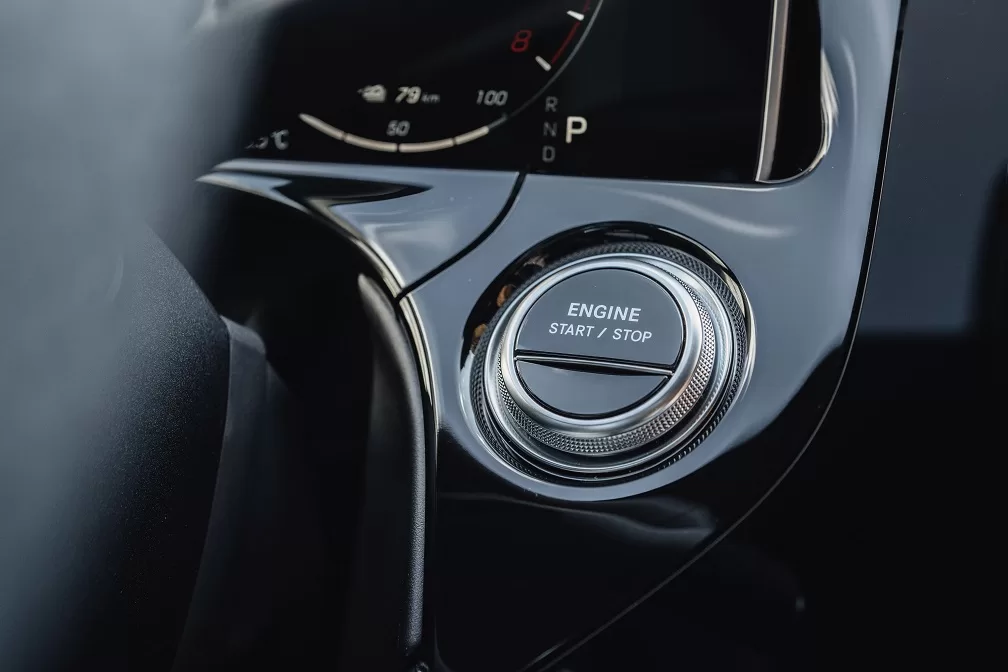
The Entertainment Package (MBUX Entertainment Plus) will be available for the new E-Class Estate. It includes Mercedes me connect services and a data package from a third-party provider. Depending on the market, a communication module with 5G as the transmission technology is used. The mobile phone standard 5G makes much faster data rates possible than LTE/UMTS.
The Digital Vehicle Key[6] is now available for the iPhone and Apple Watch
With the Digital Vehicle Key, the E-Class Estate can be started and locked simply by the driver carrying a compatible device[7] with them. Key sharing is also possible: Various digital channels can be used to invite family members or friends to use the E-Class Estate. In doing so, the vehicle owner can assign different rights, granting only access to the vehicle or also allowing it to be driven. The vehicle can recognise several users at once, and the Digital Vehicle Key can be shared by up to 16 persons. In those markets where Mercedes me connect services are available, the pre-installation for the Digital Vehicle Key forms part of the KEYLESS GO Comfort Package[8]. This equipment combination is available in the new E-Class Estate from the Premium Package onwards.
Music becomes visible: Sound Visualisation
With the new Active Ambient Lighting with Sound Visualisation, occupants in the new E-Class Estate can experience music with three senses: pieces of music and sounds from films or apps can be heard (with Dolby Atmos® technology if desired), felt (by means of sound resonating transducers in the optional Burmester® 4D surround sound system) and now also “seen”. Visualisation takes place on the light strip of the Active Ambient Lighting (optional extra). For the first time, this applies throughout in the E-Class. For example, fast sequences of beats can cause rapid light changes, while flowing rhythms can create softly merging lighting moods.
The entertainment experience for the front passenger is always impressive. On their optional screen, the front passenger can watch dynamic content such as TV or video streaming even when the driver at the wheel is looking over at them. This is because the display is switchable. The advanced camera-based privacy function automatically reduces its brightness and therefore the risk of driver distraction.
New third-party apps plus selfie and video camera
The software experts at Mercedes-Benz have developed a new compatibility layer that allows the installation of third-party apps. The following apps are available on the central display in the E-Class Estate at market launch: the entertainment platform “TikTok”, the game “Angry Birds”, the collaborative application “Webex” and the office application “Zoom” as well as the browser “Vivaldi” and the podcast app “Pocket Casts”. In addition, the ZYNC entertainment portal[11] (optionally) offers video streaming, on-demand content, interactive experiences, local video programmes, sports, news, games and much more on the central and passenger displays, via one user interface.
Another new feature is a selfie and video camera (part of the optional MBUX Superscreen) on top of the dashboard. When the vehicle is stationary, the driver can participate in online video conferences via e.g. “Webex”, and take personal photos and videos.
More operating convenience is also available with MBUX. With the “Just Talk” function, the intelligent voice control can now be activated without the keyword “Hey Mercedes”. When the function is activated, a red microphone symbol appears in the display. This indicates that the vehicle is ready and waiting for commands.
Added day-to-day convenience: the routines
Mercedes-Benz is working on the use of artificial intelligence (AI) so that the car learns which comfort systems vehicle occupants use repeatedly. Given the same circumstances, the aim is for AI to automate such functions[14]. The result is personalised automation. Mercedes-Benz uses the term ‘routine’ for this innovation, the development of which is already well advanced.
When the new E-Class Estate is launched, customers will be able to use templates for standard routines. They also have the option of creating routines themselves. In doing so, the occupants can link several functions and conditions. For example, “Switch on the seat heating and set the ambient lighting to warm orange if the interior temperature is below twelve degrees Celsius”.
For enhanced well-being: ENERGIZING COMFORT and THERMOTRONIC with Digital Vent Control (both optional)
Soothing sounds, mobilising massage, activating light – Mercedes-Benz offers a comprehensive wellness programme with the variously configured ENERGIZING COMFORT programmes and the individual recommendations of the ENERGIZING COACH. The new E-Class generation marks the debut of two innovations: The anti-travel sickness programme of ENERGIZING COMFORT can help affected passengers to alleviate symptoms. A bio-feedback function is planned for the ENERGIZING COACH in the medium term. This can reduce the feeling of stress with breathing exercises.
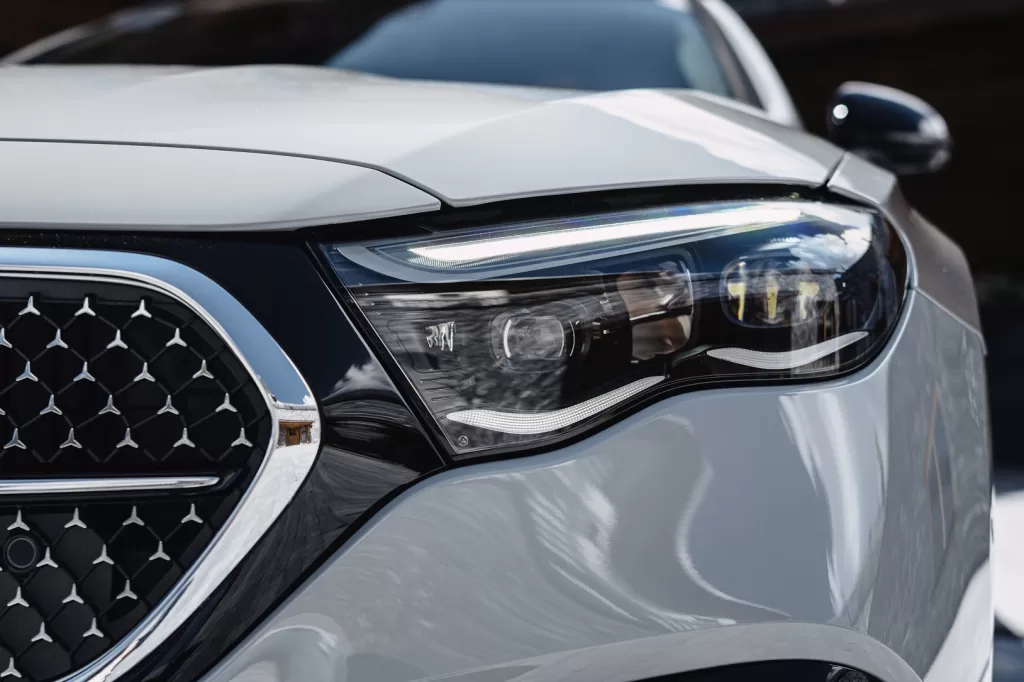
With THERMOTRONIC automatic climate control (optional extra), Digital Vent Control enhances the comfort experience. It automatically adjusts the front air vents to a desired ventilation scenario. This can be done for each seat via the user profile, for example. However, the nozzles can also be aligned by hand as usual.
Numerous driving assistance systems, some of which have been developed further
The standard equipment of the E-Class Estate with driving assistance systems includes Active Distance Assist DISTRONIC, ATTENTION ASSIST, Active Brake Assist, Active Lane Keeping Assist, Parking Package with reversing camera and Speed Limit Assist. The status and activity of the driving assistance systems are shown as a full-screen view in the Assistance mode of the driver’s display.
The Driving Assistance Plus package is also offered as an optional extra, for example as part of the Premium package. Components include Active Steering Assist, which assists with lane-keeping. As already on motorways, the E-Class can now also restart automatically in city traffic and on country roads after a longer standstill. Another new feature: If Active Steering Assist is no longer available because the lane markings are not clearly visible, it signals this to the driver by means of vibration on the steering wheel.
Sophisticated body concept and coordinated restraint systems
The safety concept of the E-Class Estate is based on a body with a particularly rigid passenger cell and specifically deformable crash structures. The restraint systems, e.g. seat belts and airbags, are specifically adapted to this. In the event of an accident, they can be activated in such a way that their protective effect for the occupants is adapted to the situation.
In addition to driver and front passenger airbags, a knee airbag on the driver’s side is also standard. It can protect the legs from contact with the steering column or instrument panel in a severe frontal crash. The standard windowbags can reduce the risk of head injuries. In the event of a serious side-on collision, the window airbag on the side of the impact extends from the A- to the C-pillar like a curtain over the front and rear side windows. If a rollover is detected, the window airbags can be activated on both sides. In addition to the head protection system, side airbags can also protect the thorax area in the event of a severe side impact – including on the outer rear seats as an option.
In addition, the vehicles are equipped with a centre airbag, depending on the country. Pyrotechnic belt tensioners and force limiters are standard on all outer seats, as are seat belt height adjusters.
Resource-conserving materials
Numerous E-Class Estate components are made partly from resource-saving materials (recyclates and renewable raw materials). Upholstery made of undyed alpaca wool combined with a recycled material is used for the basic seat. For the first time, certified recycled raw materials are used in the foam of the seats according to the “mass balance approach”. These have the same properties as raw materials produced from petroleum. In this way, the need for fossil resources can be reduced while maintaining product quality.
Neutral CO₂ balance in production at the Sindelfingen plant
Since 2022, Mercedes-Benz has been producing with a neutral CO₂ balance in all of its own plants worldwide. The externally sourced electricity comes exclusively from renewable energies, and is therefore CO₂-free. In addition, the company aims to increase the generation of renewable energy at its locations. Investments will be made in a further expansion of photovoltaics at the entire Sindelfingen location by the end of 2024. Another focus at the Sindelfingen location is on constantly reducing water consumption and the amount of waste produced.
The E-Class Estate as a long-standing success story
Mercedes-Benz has produced more than 16 million upper mid-range vehicles since 1946. In August 1966, the Mercedes-Benz Universal made its debut in the official sales programme. It was an estate car built by Belgian partner IMA on the basis of the 200 D to 230 S tail fin versions – the first official Mercedes-Benz estate car.
In April 1978, the Estate 123 model series entered production and a long success story began – well over a million estate models have been built to date. In Germany, the Estate is known as the “T‑Modell” and although the “T” suggests tourism and transport, it also stands for trendsetter. For Mercedes-Benz, the estate model is now an integral part of the luxury segment and has a loyal fan base, particularly in Germany. There has been an estate in every successive generation of the E‑Class (S 124, S 210, S 211, S 212, S 213, as well an All-Terrain version since 2017).

